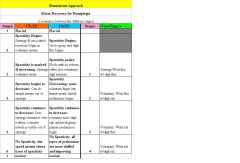![]()
![]()
![]()
Use LEFT and RIGHT arrow keys to navigate between flashcards;
Use UP and DOWN arrow keys to flip the card;
H to show hint;
A reads text to speech;
9 Cards in this Set
- Front
- Back
|
Brunnstrum Approach:
What is the premise of this approach? |
To evaluate at what stage the pt is in and start there and progress to next stage, but have pt successful in current stage.
|
|
|
Why does Brunnstrum believe hemi pt's have stages to go through in order to elicit normal ms movement again
|
Because the trauma to the CNS has had an "evolution in reverse" that the patterns have regressed to primitive patterns.
|
|
|
What are the regressed patterns the hemi pt regresses to?
|
synergies and reflexes
|
|
|
what are synergies?
|
gross ms group movements that whether reflexively or voluntary move bound (together).
|
|
|
The Brunnstrum Motor Recovery Stages of Hemiplegia
|

*
|
|
|
What type of techniques should be used in stages 1-2?
|
Facilitory: to elicit synergy (tone) thru reflexes, BUT IMMEDIATELY followed by faciliation of the externsors
|
|
|
What type of techniques should be used in stages 2...going to 3-4?
|
Inhibitory: to break away from synergy mvmts (pt can do voluntary mvmt). Promote mvmt that use flexor and extensor synergy COMBO's.
|
|
|
What type of techniques should be used in stages 4...going to 5-6?
|
to gain voluntary control of ISOLATED mvmnt. Start enabling skilled tech: buttoning, zippers, fasterners, shoelace tie, writing
In 6 start to increase speed. |
|
|
In theory, when can strengthening begin
|
stage 5
|

